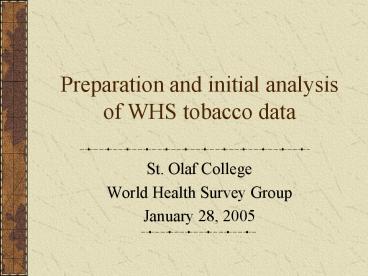Preparation and initial analysis of WHS tobacco data - PowerPoint PPT Presentation
1 / 36
Title:
Preparation and initial analysis of WHS tobacco data
Description:
To clean and perform an initial analysis on tobacco-related data ... Gender symbolism. Religious expectations. Suggestions for future. research & analysis ... – PowerPoint PPT presentation
Number of Views:44
Avg rating:3.0/5.0
Title: Preparation and initial analysis of WHS tobacco data
1
Preparation and initial analysis of WHS tobacco
data
- St. Olaf College
- World Health Survey Group
- January 28, 2005
2
Project Objective
- To clean and perform an initial analysis on
tobacco-related data provided by the World Health
Survey
3
World Health Survey
- Designed to provide a comprehensive database from
which to describe the health of many of the
worlds developing countries.
4
World Health Survey
- Health risk factors
- Physical activity
- Tobacco
- Alcohol
- Nutrition
- Environmental factors
5
World Health Survey
- Provides
- First-time standardized data
- Coverage for developing countries.
6
World Health Survey
- Applications
- Monitor health systems
- Inform policy-makers
- Institute programs aimed at reducing health risks
7
WHS Tobacco Questionnaire
- Q4000 Do you currently smoke any tobacco
products such as cigarettes, cigars, or pipes? - No, not at all non-smoker
- Yes, but not daily occasional smoker
- Daily daily smoker
8
WHS Tobacco Questionnaire
- For daily smokers
- Q4001 For how many years are you smoking daily?
9
WHS Tobacco Questionnaire
- For daily smokers
- Q4002-4005 On average, how many of the
following products are you smoking daily? - Manufactured cigarettes
- Hand-rolled cigarettes
- Pipefuls of tobacco
- Other
10
Data description
- 32 countries
- 26 countries with blank records
- 10,168 total blank records
- 184,878 respondents
11
Variables used
- Sex
- Age/Age range
- Education level
- Years of education
- Current job
- Setting
- Smoking status
- Years of smoking
- Type of product
- Manufactured cigarettes
- Hand-rolled cigarettes
- Pipefuls of tobacco
- Other tobacco products
12
Data description
- Complete responses pre-cleaning
- 128,631 complete responses
- 69.6 of responses complete
13
The cleaning process do-file
- Contains data cleaning documentation
- Executable for future cleaning
14
Highlights of do-file
- Purposeful missings .a
- Illogical/invalid responses
15
Highlights of do-File
- Generate age_bar and agerange_2
16
Highlights of do-file
- Standardization of education levels
- Based on U.S. educational system
- 1 no formal education (0 years)
- 2 less than primary school (1-5 years)
- 3 primary school completed (6 years)
- 4 secondary school completed (7-8 years)
- 5 high school completed (9-12 years)
- 6 college/pre-university/university completed
(13-16 years) - 7 post-graduate degree completed (17 years)
17
Post-cleaning data description
- Complete responses post-cleaning
- 132,406 complete responses
- 71.6 (vs. 69.6 pre-cleaning) of responses
complete
18
Data analysis objectives
- Determine proportions by country for
- Current daily smoker
- Occasional smoker
- Non-smoker
- Compare these proportions by
- Sex
- Age group
- Standardized education level
- Current occupation
- Urban/rural status
19
Data analysis objectives
- Determine the mean number of tobacco products
smoked for each of the following - Manufactured cigarettes
- Hand-rolled cigarettes
- Pipes
- Other tobacco products
20
Methods for data analysis
- Generate analysis do-file
- Construct confidence intervals
- Future methods
- pweights
21
Data analysis methods
- Itemized non-response
22
Selected results Two global trends
- Countries with higher proportion of daily smokers
were typically eastern European and SE Asian - Countries with the lowest proportion were
typically African or Latin American
23
(No Transcript)
24
(No Transcript)
25
Selected results Age
- Highest proportion of daily smokers seen in
respondents 40-59 years of age.
26
Selected results Age
- Eastern European countries higher proportions of
younger daily smokers - Slovakia, Estonia, Turkey, Hungary, Croatia
- SE Asian countries higher proportions of older
daily smokers - Bangladesh, Nepal, Laos, India
27
(No Transcript)
28
(No Transcript)
29
(No Transcript)
30
(No Transcript)
31
Limitations of cleaning analysis
- Enhance comparability by
- Use of pweights
- Standardizing age
- Lack of background information
- Sampling techniques
- Sample size
- Non-respondents/blank records
32
Limitations of cleaning analysis
- Questionnaire difficulties
- Education level definition
- Wording of tobacco question
- Overly broad definition of occasional
- Cultural limitations
33
Interpretation of results
- Eastern Europe SE Asia higher proportions of
daily smokers. Why?
- Higher incomes
- Lifestyle differences
- Economic proximity/increased trade with
producers - Increased Western cultural influence
- Recent political upheaval
34
Interpretation of results
- Gender split in daily smoker proportions. Why?
- Social acceptability bias
- Different stigmas for women men
- Economic access for women
- Gender symbolism
- Religious expectations
35
Suggestions for future research analysis
- Explore interactions
- Age distribution by sex
- Sex by urban/rural status
- Applying demographics
- GDP comparisons
- Life expectancy
- Literacy rates
- Infant mortality rates
36
Further studies
- For pre-18 year-old smokers age of smoking
initiation - Advertising/Marketing techniques employed
regionally - More economically inclusive regional surveys
- Countries with Tobacco-Free Initiative































